Optimal Speed Ranges for Different Vehicle Types for Exhaust Emission Control
Abstract
:1. Introduction
2. Method
2.1. Approach Overview
2.2. Single-Vehicle Exhaust Emission Test
2.3. Traffic Flow Exhaust Emissions Based on the MOVES Model
3. Results and Discussion
3.1. Typical Emissions for Single Vehicles
3.1.1. Exhaust Emissions from a Light Passenger Vehicle Traveling at Different Speeds
- Changes in emission accumulation
- 2.
- Variations in emission factors
3.1.2. Exhaust Emissions from a Freight Vehicle Traveling at Different Speeds
- 1.
- Changes in emission accumulation
- 2.
- Variations in specific emissions
3.2. Typical Emissions for Traffic Flow
3.2.1. Emission Characteristics of Light Passenger Vehicles Traveling at Different Speeds
- CO has the highest emission rate, followed by HCs, NOx, and PM2.5. A significant difference in the order of magnitude of the emission rates is clear; for example, CO emissions are nearly 100 times those of PM2.5, about twice those of HCs, and 5 to 10 times those of NOx.
- Within the simulated speed range, the CO emission rates decrease with the increase in speed. The lower the vehicle speed, the faster the reduction in CO emissions, which follows an initial rapid decline that gradually levels off.
- The trend in HCs emissions is opposite that of CO; HCs emissions increase slowly at first and then rapidly as the speed increases.
- NOx emissions gradually decrease with the increase in speed, reaching a minimum of 1.15 g/km at 100 km/h; when increasing speed from 100 km/h, NOx emissions increase again.
- PM2.5 emissions show an overall increasing trend with speed; however, at 80 km/h, their rate drops to a minimum of 0.0067 g/km.
3.2.2. Emission Characteristics of Freight Vehicles Traveling at Different Speeds
- Notable differences in the magnitudes of the emission factors are evident among the four types of heavy trucks. NOx emissions are the highest, followed by CO, PM2.5, and then HCs. Specifically, NOx emissions are about ten times those of CO, nearly thirty times those of PM2.5, and close to ten thousand times those of HCs.
- Regarding the differences in emissions among vehicle types, the following trend was observed: N4-large heavy-duty vehicles > N3-medium heavy-duty vehicles > N2-light heavy-duty vehicles > N1-minivans. The emission rates of N2 and N1 are quite similar, while the emissions of N3 are approximately double that of N2. N4 vehicles emit about twice the CO and PM2.5 emitted by N3 vehicles, whereas NOx and HCs emissions show similar magnitudes for these two vehicle types.
- The trends in CO, PM2.5, and HCs emissions across the four vehicle types are consistent: they all decrease with the increase in speed, initially dropping rapidly before tapering off. At low speeds, freight vehicle engines operate under low loads, leading to reduced combustion efficiency. As speed increases, the engine transitions to a more stable operating condition, resulting in improved combustion efficiency [60]. Increasing speed up to 80 km/h, the decrease in CO, PM2.5, and HCs emissions is more pronounced; above 90 km/h, the reduction becomes slower. The steepest declines for these three emission factors occur within the 80–90 km/h range.
- In contrast, NOx emissions increase at higher vehicle speeds. As vehicle speed increases, the engine’s power demand rises, leading to elevated combustion chamber temperatures and pressures, which significantly promote the formation of NOx. Increasing speed up to 90 km/h, the increase in NOx emissions is gradual; however, above 100 km/h, the rate of increase accelerates. In the range of 90–100 km/h, the increase in NOx emission rate is slowest.
- Similarly to M1-light passenger vehicles traffic flow, the MOVES non-exhaust emissions module was utilized to generate non-exhaust sources of PM. These were combined with the PM from exhaust emissions to analyze the PM2.5 and PM10 produced during freight vehicle traffic flow, as shown in Figure 10. Numerically, the total PM was significantly higher than CO and HCs emissions and second only to NOx. The primary contributors were brake system and tire wear. Both PM2.5 and PM10 decreased with increasing speed, with a marked reduction in PM generation observed at speeds exceeding 80 km/h.
3.3. Total Exhaust Emission Characteristics
3.4. Carbon Emission Characteristics
4. Conclusions
4.1. Comparison of Emission Characteristics
4.1.1. Exhaust Emissions from Light Passenger Vehicles and Freight Vehicles
- By comparing the results from real-vehicle exhaust tests, it is evident that N- freight vehicles produce significantly higher exhaust emissions than M1. However, both vehicle types exhibit a similar trend in total exhaust emissions, which can be modeled with a quadratic function relative to the speed. Specifically, the speed corresponding to the minimum total exhaust emissions depends on vehicle type, i.e., 100 km/h for M1 and 70 km/h for N, indicating that the optimal speed for the former vehicle type is higher.
- The carbon emissions of M1 display a quadratic relationship with speed, showing a minimum carbon emission value within a plausible speed range, while N vehicles demonstrate a linear relationship, where carbon emissions decrease with the increase in speed.
- Regarding emission factors, significant differences in exhaust emission characteristics were observed between M1 and N at different speeds. At low speeds, M1 vehicles exhibit higher CO emissions due to incomplete combustion, with CO accounting for approximately 70% of the total exhaust. As the vehicle speed increases, combustion efficiency improves, leading to a gradual decrease in CO emissions, while NOx emissions increase.
- In contrast, N vehicles primarily emit NOX due to the high-pressure combustion characteristics of diesel engines, which generate a large amount of NOX under high-temperature, high-pressure conditions. Additionally, the PM2.5 emissions from freight vehicles are significantly higher than those from light passenger vehicles.
- Additionally, the PM emissions generated during vehicle operation exhibit distinct patterns between M1 and N vehicles. The PM2.5 and PM10 emissions of M1 are relatively low and follow a “U”-shaped trend as speed increases. The optimal speed range for minimizing PM2.5 emissions is between 80–110 km/h, while speeds above 90 km/h correspond to lower PM10 emissions. In contrast, N-freight vehicles, characterized by higher loads and diesel engine properties, emit significantly more particulate matter. For these vehicles, PM emissions decrease consistently with increasing speed. Based on the trends of PM2.5 and PM10 emissions, speeds above 90 km/h are identified as optimal for reducing PM emissions from freight vehicles.
4.1.2. Single-Vehicle Emissions vs. Traffic Flow Emissions
- The emission levels of typical factors differ between the single-vehicle and traffic flow cases. For M1-light passenger vehicles, the ranking of typical emission factors in both single-vehicle and traffic flow emissions is as follows: CO > HCs > NOx > PM2.5. CO emissions far exceed those of the other factors, indicating that CO is the primary pollutant in M1-light passenger vehicle exhaust.
- The trends in typical emission factors differ between the single-vehicle and traffic flow cases. In the former, CO initially decreases before increasing with speed, whereas in the latter, CO decreases with speed. HCs emissions in single-vehicle exhaust show an overall downward trend with some fluctuations; NOx and PM2.5 emissions increase with speed.
- For N-freight vehicles, the ranking of typical emission factors is NOx > CO > PM2.5 > HCs, indicating that NOx is the primary pollutant. In single-vehicle emissions, CO, HCs, and PM2.5 decrease with the increase in speed, while NOx initially decreases and then increases. In traffic flow emissions, the trends for CO, PM2.5, and HCs are consistent with those for single-vehicle emissions, while NOx increases with vehicle speed.
4.2. Speed Limits
Author Contributions
Funding
Institutional Review Board Statement
Informed Consent Statement
Data Availability Statement
Conflicts of Interest
References
- Olmo, N.R.S.; do Nascimento Saldiva, P.H.; Braga, A.L.F.; Lin, C.A.; de Paula Santos, U.; Pereira, L.A.A. A review of low-level air pollution and adverse effects on human health: Implications for epidemiological studies and public policy. Clinics 2011, 66, 681–690. [Google Scholar] [CrossRef] [PubMed]
- Hossain Lipu, M.S.; Miah, M.S.; Ansari, S.; Wali, S.B.; Jamal, T.; Elavarasan, R.M.; Kumar, S.; Naushad Ali, M.M.; Sarker, M.R.; Aljanad, A.; et al. Smart Battery Management Technology in Electric Vehicle Applications: Analytical and Technical Assessment toward Emerging Future Directions. Batteries 2022, 8, 219. [Google Scholar] [CrossRef]
- Yadav, D.; Goyal, R.; Yadav, V.S. A review of control strategies for automotive evaporative emissions practiced worldwide. AIP Conf. Proc. 2019, 2148, 30024. [Google Scholar]
- Liu, X.; Li, X.; Wang, X.; Tai, S.; Hou, W.; Zhang, Y.; Yue, M. A Multi-Physics Control Model for Automotive Proton Exchange Membrane Fuel Cells. In Proceedings of the 2024 International Conference on Control, Automation and Diagnosis (ICCAD), Paris, France, 15–17 May 2024; pp. 1–5. [Google Scholar]
- Gren, L.; Malmborg, V.B.; Falk, J.; Markula, L.; Novakovic, M.; Shamun, S.; Eriksson, A.C.; Kristensen, T.B.; Svenningsson, B.; Tunér, M.; et al. Effects of renewable fuel and exhaust aftertreatment on primary and secondary emissions from a modern heavy-duty diesel engine. J. Aerosol Sci. 2021, 156, 105781. [Google Scholar] [CrossRef]
- Emission Standards: Europe: Heavy-Duty Truck and Bus Engines. Available online: https://dieselnet.com/standards/eu/hd.php (accessed on 19 November 2024).
- Proposed Rule for Amendments Related to: Tier 3 Motor Vehicle Emission and Fuel Standards, Nonroad Engine and Equipment|US EPA. Available online: https://www.epa.gov/regulations-emissions-vehicles-and-engines/proposed-rule-amendments-related-tier-3-motor-vehicle (accessed on 19 November 2024).
- Limits and Measurement Methods for Emissions from Light-Duty Vehicles (CHINA 6)_Ministry of Ecological Environment of the People’s Republic of China. Available online: https://www.mee.gov.cn/ywgz/fgbz/bz/bzwb/dqhjbh/dqydywrwpfbz/201612/t20161223_369476.shtml (accessed on 19 November 2024).
- Vehicle Standards Historical Documents. Available online: https://www.infrastructure.gov.au/infrastructure-transport-vehicles/vehicles/vehicle-design-regulation/vehicle-standards-historical-documents (accessed on 19 November 2024).
- Mu, M.; Li, X.; Qiu, Y.; Shi, Y. Study on a New Gasoline Particulate Filter Structure Based on the Nested Cylinder and Diversion Channel Plug. Energies 2019, 12, 2045. [Google Scholar] [CrossRef]
- Wu, G.; Feng, G.; Li, Y.; Ling, T.; Peng, X.; Su, Z.; Zhao, X. A Review of Thermal Energy Management of Diesel Exhaust after-Treatment Systems Technology and Efficiency Enhancement Approaches. Energies 2024, 17, 584. [Google Scholar] [CrossRef]
- De Nino, A.; Maiuolo, L.; Costanzo, P.; Algieri, V.; Jiritano, A.; Olivito, F.; Tallarida, M.A. Recent Progress in Catalytic Synthesis of 1,2,3-Triazoles. Catalysts 2021, 11, 1120. [Google Scholar] [CrossRef]
- Giechaskiel, B.; Melas, A.; Valverde, V.; Otura, M.; Martini, G. Challenging Conditions for Gasoline Particulate Filters (GPFs). Catalysts 2022, 12, 70. [Google Scholar] [CrossRef]
- Garcia, E.; Triantopoulos, V.; Trzaska, J.; Taylor, M.; Li, J.; Boehman, A.L. Extreme Miller cycle with high intake boost for improved efficiency and emissions in heavy-duty diesel engines. Int. J. Engine Res. 2021, 24, 552–566. [Google Scholar] [CrossRef]
- DeRoy, P.; Ramanujan, A.; Rostamzadeh, C.; Worden, M.; Monti, T.; Schulz, W. Investigation of the Effectiveness of RF Absorbers for Mitigation of Automotive Radiated Emission by Measurement and Simulation. In Proceedings of the 2019 IEEE International Symposium on Electromagnetic Compatibility, Signal & Power Integrity (EMC+SIPI), New Orleans, LA, USA, 22–26 July 2019; pp. 178–183. [Google Scholar]
- Paulo Bressan, C.D.C. Application of Hall Effect Sensor in temperature control valve of automotive Internal Combustion Engine. Int. J. Adv. Eng. Res. Sci. 2019, 4, 439–443. [Google Scholar] [CrossRef]
- Saravanan, M.; Senthil, J.; Sudhakar, S.; Sathish Kumar, L.; Sowmithri, O. Embedded Control System for Recent Petrol Engine Control. Int. J. Innov. Technol. Explor. Engineering 2019, 9, 508–511. [Google Scholar]
- Bishop, J.D.K.; Molden, N.; Boies, A.M. Using portable emissions measurement systems (PEMS) to derive more accurate estimates of fuel use and nitrogen oxides emissions from modern Euro 6 passenger cars under real-world driving conditions. Appl. Energ. 2019, 242, 942–973. [Google Scholar] [CrossRef]
- Wang, P.; Zhang, R.; Sun, S.; Gao, M.; Zheng, B.; Zhang, D.; Zhang, Y.; Carmichael, G.R.; Zhang, H. Aggravated air pollution and health burden due to traffic congestion in urban China. Atmos. Chem. Phys. 2023, 23, 2983–2996. [Google Scholar] [CrossRef]
- Fondzenyuy, S.K.; Turner, B.M.; Burlacu, A.F.; Jurewicz, C.; Usami, D.S.; Feudjio, S.L.T.; Persia, L. The Impact of Speed Limit Change on Emissions: A Systematic Review of Literature. Sustainability 2024, 16, 7712. [Google Scholar] [CrossRef]
- Skrúcaný, T.; Kendra, M.; Stopka, O.; Milojević, S.; Figlus, T.; Csiszár, C. Impact of the Electric Mobility Implementation on the Greenhouse Gases Production in Central European Countries. Sustainability 2019, 11, 4948. [Google Scholar] [CrossRef]
- Shang, X.; Huang, S.; Zheng, J. A Study on Time-Varying Synergy of Energy Consumption, Economic Growth, and CO2 Emissions in China. J. Adv. Comput. Intell. Intell. Inform. 2023, 27, 1056–1069. [Google Scholar] [CrossRef]
- André, M.; Hammarström, U. Driving speeds in Europe for pollutant emissions estimation. Transp. Res. Part D Transp. Environ. 2000, 5, 321–335. [Google Scholar] [CrossRef]
- Moawad, A.; Zebiak, M.; Han, J.; Karbowski, D.; Zhang, Y.; Rousseau, A. Effect of adaptive cruise control on fuel consumption in real-world driving conditions. Nat. Commun. 2024, 15, 10016. [Google Scholar] [CrossRef]
- Li, Z.; Ming-ming, F.; Yang, L.; Hong, C.; Rui, W.; Zhi-kun, Y. Construction of a Trip Dynamic Factor to Characterize the Real Driving Emissions of Vehicles. China J. Highw. Transp. 2024, 37, 315–324. [Google Scholar]
- Du, X.; Kang, X.; Gao, Y.; Wang, X. Driving behavior characterization and traffic emission analysis considering the vehicle trajectory. Front. Psychol. 2024, 14, 1341611. [Google Scholar] [CrossRef]
- Lyu, Z.; Pons, D.; Zhang, Y. Emissions and Total Cost of Ownership for Diesel and Battery Electric Freight Pickup and Delivery Trucks in New Zealand: Implications for Transition. Sustainability 2023, 15, 7902. [Google Scholar] [CrossRef]
- Dhital, N.B.; Wang, S.; Lee, C.; Su, J.; Tsai, M.; Jhou, Y.; Yang, H. Effects of driving behavior on real-world emissions of particulate matter, gaseous pollutants and particle-bound PAHs for diesel trucks. Environ. Pollut. 2021, 286, 117292. [Google Scholar] [CrossRef] [PubMed]
- Acuto, F.; Coelho, M.C.; Fernandes, P.; Giuffrè, T.; Macioszek, E.; Granà, A. Assessing the Environmental Performances of Urban Roundabouts Using the VSP Methodology and AIMSUN. Energies 2022, 15, 1371. [Google Scholar] [CrossRef]
- Goedertier, F.; Weijters, B.; Vanpaemel, P. The Longitudinal Effect of Digitally Administered Feedback on the Eco-Driving Behavior of Company Car Drivers. Sustainability 2023, 15, 16571. [Google Scholar] [CrossRef]
- Al-Hadhrami, B.M. Implementation of a Management System to Mitigate Carbon Dioxide Emissions from Light Vehicles Transportation Through Improved Driving Behavior in the State of Kuwait. In Proceedings of the SPE International Health, Safety, Environment and Sustainability Conference and Exhibition, Abu Dhabi, United Arab Emirates, 10–12 September 2024; p. D021S017R005. [Google Scholar]
- He, W.; Duan, L.; Zhang, Z.; Zhao, X.; Cheng, Y. Analysis of the Characteristics of Real-World Emission Factors and VSP Distributions—A Case Study in Beijing. Sustainability 2022, 14, 11512. [Google Scholar] [CrossRef]
- Aggelakakis, A.; Anagnostopoulou, A.; Tromaras, A.; Boile, M.; Mantzinou, N. Influence of Traffic Emissions on Urban Air Quality: A Case Study of a Medium Sized City; Springer International Publishing: Cham, Switzerland, 2019; pp. 323–329. [Google Scholar]
- Lyu, P.; Wang, P.S.; Liu, Y.; Wang, Y. Review of the studies on emission evaluation approaches for operating vehicles. J. Traffic Transp. Eng. Engl. Ed. 2021, 8, 493–509. [Google Scholar] [CrossRef]
- Duan, Y.; Gao, Y.; Zhao, J.; Xue, Y.; Zhang, W.; Wu, W.; Jiang, H.; Cao, D. Agricultural Methane Emissions in China: Inventories, Driving Forces and Mitigation Strategies. Environ. Sci. Technol. 2023, 57, 13292–13303. [Google Scholar] [CrossRef]
- Miotti, M.; Needell, Z.A.; Ramakrishnan, S.; Heywood, J.; Trancik, J.E. Quantifying the impact of driving style changes on light-duty vehicle fuel consumption. Transp. Res. Part D Transp. Environ. 2021, 98, 102918. [Google Scholar] [CrossRef]
- Wu, J.; Qu, X. Intersection control with connected and automated vehicles: A review. J. Intell. Connect. Veh. 2022, 5, 260–269. [Google Scholar] [CrossRef]
- Luo, Y.; Ci, Y.; Jiang, S.; Wei, X. A novel lightweight real-time traffic sign detection method based on an embedded device and YOLOv8. J. Real-Time Image Process. 2024, 21, 24. [Google Scholar] [CrossRef]
- Yang, J.; Wang, P.; Ju, Y. Variable Speed Limit Intelligent Decision-Making Control Strategy Based on Deep Reinforcement Learning under Emergencies. Sustainability 2024, 16, 965. [Google Scholar] [CrossRef]
- Li, H.; Zhang, T.; Hgao, C.; Wang, J. Prediction Method for Remaining Useful Life of Rolling Bearings Using Variable Interval Sampling. In Proceedings of the 2022 IEEE 6th Information Technology and Mechatronics Engineering Conference (ITOEC), Chongqing, China, 4–6 March 2022; pp. 55–60. [Google Scholar]
- Jin-jun, T.; Qiang, F.; Cheng-cheng, W.; Chen, Y.; Xuan, Z.; Chang-jing, X. Multi-objective Optimization of Variable Speed Limit Control Strategy on Expressway. J. Transp. Syst. Eng. Inf. Technol. 2023, 23, 252–261. [Google Scholar]
- Wei-wei, L.; Jian-bei, L.; Qiang, Y.; Zhong-bin, L.; Jian-qiang, G. Variable Speed Limit Method for Rainy Weather Considering Freeway Operation Risk. China J. Highw. Transp. 2022, 35, 38–50. [Google Scholar]
- Wu, L.; Ci, Y.; Sun, Y.; Qi, W. Research on Joint Control of On-Ramp Metering and Mainline Speed Guidance in the Urban Expressway Based on MPC and Connected Vehicles. J. Adv. Transp. 2020, 2020, 7518087. [Google Scholar] [CrossRef]
- Ghadiri, S.M.; Torkan, R.; Mohd Sadullah, A.F. Speed Limit Compliance Index (SLCI): A Conceptual Method to Enhance the Efficiency of the Advisory Intelligent Speed Adaptation System. J. Adv. Transp. 2022, 2022, 2452922. [Google Scholar] [CrossRef]
- Qu, X.; Yang, M.; Ji, J.; Li, L.; Ran, B. Analyzing the Safety Impacts of Variable Speed Limit Control on Aggregated Driving Behavior Based on Traffic Big Data. J. Adv. Transp. 2021, 2021, 8823292. [Google Scholar] [CrossRef]
- McCarthy, P.; Rasul, M.G.; Moazzem, S. Comparison of the performance and emissions of different biodiesel blends against petroleum diesel. Int. J. Low-Carbon Technol. 2011, 6, 255–260. [Google Scholar] [CrossRef]
- Wang, Y.; Hao, C.; Ge, Y.; Hao, L.; Tan, J.; Wang, X.; Zhang, P.; Wang, Y.; Tian, W.; Lin, Z.; et al. Fuel consumption and emission performance from light-duty conventional/hybrid-electric vehicles over different cycles and real driving tests. Fuel 2020, 278, 118340. [Google Scholar] [CrossRef]
- Huang, Y.; Ng, E.C.Y.; Zhou, J.L.; Surawski, N.C.; Lu, X.; Du, B.; Forehead, H.; Perez, P.; Chan, E.F.C. Impact of drivers on real-driving fuel consumption and emissions performance. Sci. Total Environ. 2021, 798, 149297. [Google Scholar] [CrossRef]
- Huang, J.; Gao, J.; Wang, Y.; Yang, C.; Ma, C. Real-World Pipe-Out Emissions from Gasoline Direct Injection Passenger Cars. Processes 2023, 11, 66. [Google Scholar] [CrossRef]
- Fayyazbakhsh, A.; Bell, M.L.; Zhu, X.; Mei, X.; Koutný, M.; Hajinajaf, N.; Zhang, Y. Engine emissions with air pollutants and greenhouse gases and their control technologies. J. Clean Prod. 2022, 376, 134260. [Google Scholar] [CrossRef]
- Wu, X.; Zhang, S.; Wu, Y.; Li, Z.; Ke, W.; Fu, L.; Hao, J. On–road measurement of gaseous emissions and fuel consumption for two hybrid electric vehicles in Macao. Atmos. Pollut. Res. 2015, 6, 858–866. [Google Scholar] [CrossRef]
- Kwak, J.; Park, B.; Lee, J. Evaluating the impacts of urban corridor traffic signal optimization on vehicle emissions and fuel consumption. Transp. Plan. Technol. 2012, 35, 145–160. [Google Scholar] [CrossRef]
- Liao, T. A fuel-based signal optimization model. Transp. Res. Part D Transp. Environ. 2013, 23, 1–8. [Google Scholar] [CrossRef]
- Pandian, S.; Gokhale, S.; Ghoshal, A.K. Evaluating effects of traffic and vehicle characteristics on vehicular emissions near traffic intersections. Transp. Res. Part D Transp. Environ. 2009, 14, 180–196. [Google Scholar] [CrossRef]
- Wu, L.; Ci, Y.; Chu, J.; Zhang, H. The Influence of Intersections on Fuel Consumption in Urban Arterial Road Traffic: A Single Vehicle Test in Harbin, China. PLoS ONE 2015, 10, e0137477. [Google Scholar] [CrossRef]
- GB 17691-2005; Limits and measurement methods for exhaust pollutantsfrom compression ignition and gas fuelled positive ignition engines of vehicles (III, IV, V). China Environmental Science Press: Beijing, China, 2005.
- Ayissi, M.Z.; Newen, I.A.; Alloune, R.; Bitondo, D. Effects of Gasoline and Hydrogen Blends on Exhaust Gas Emissions and Fuel Consumption from Gasoline Internal Combustion Engines. J. Combust. 2022, 2022, 5526205. [Google Scholar] [CrossRef]
- Fussell, J.C.; Franklin, M.; Green, D.C.; Gustafsson, M.; Harrison, R.M.; Hicks, W.; Kelly, F.J.; Kishta, F.; Miller, M.R.; Mudway, I.S.; et al. A Review of Road Traffic-Derived Non-Exhaust Particles: Emissions, Physicochemical Characteristics, Health Risks, and Mitigation Measures. Environ. Sci. Technol. 2022, 56, 6813–6835. [Google Scholar] [CrossRef]
- Wang, X.; Gronstal, S.; Lopez, B.; Jung, H.; Chen, L.A.; Wu, G.; Ho, S.S.H.; Chow, J.C.; Watson, J.G.; Yao, Q.; et al. Evidence of non-tailpipe emission contributions to PM(2.5) and PM(10) near southern California highways. Environ. Pollut. 2023, 317, 120691. [Google Scholar] [CrossRef]
- Puškár, M.; Fil’O, M.; Kopas, M.; Harachová, D.K. Analysis of Various Factors’ Influence and Optimization of Low-Temperature Combustion Technology. ACS Omega 2024, 11, 13274–13283. [Google Scholar] [CrossRef]
- Reşitoğlu, İ.A.; Altinişik, K.; Keskin, A. The pollutant emissions from diesel-engine vehicles and exhaust aftertreatment systems. Clean Technol. Environ. 2015, 17, 15–27. [Google Scholar] [CrossRef]
- Ravi, S.S.; Osipov, S.; Turner, J.W.G. Impact of Modern Vehicular Technologies and Emission Regulations on Improving Global Air Quality. Atmosphere 2023, 14, 1164. [Google Scholar] [CrossRef]
- Yan, L.; Zhang, Q.; Zheng, B.; He, K. Modeling fuel-, vehicle-type-, and age-specific CO2 emissions from global on-road vehicles in 1970–2020. Earth Syst. Sci. Data 2024, 16, 4497–4509. [Google Scholar] [CrossRef]



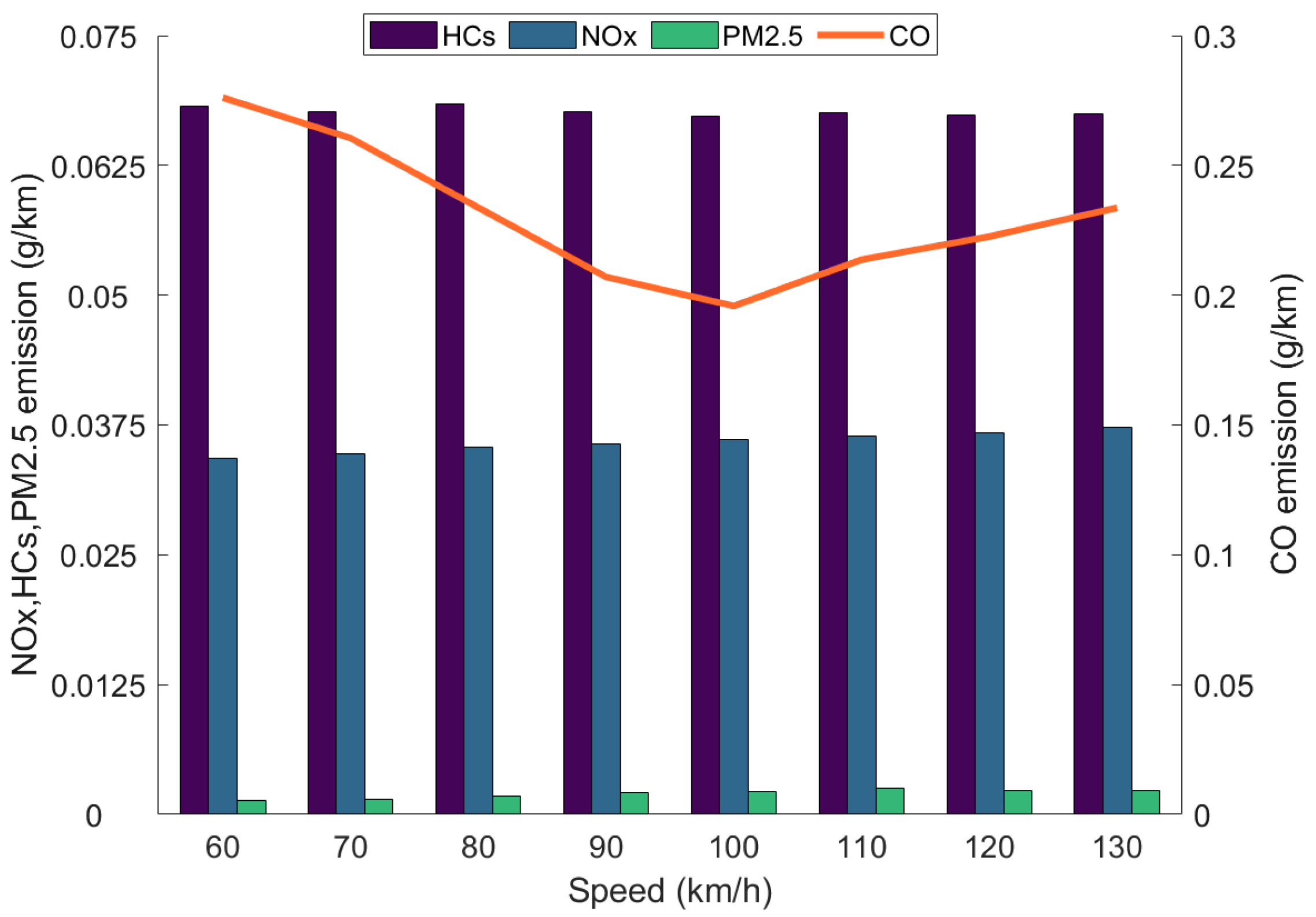


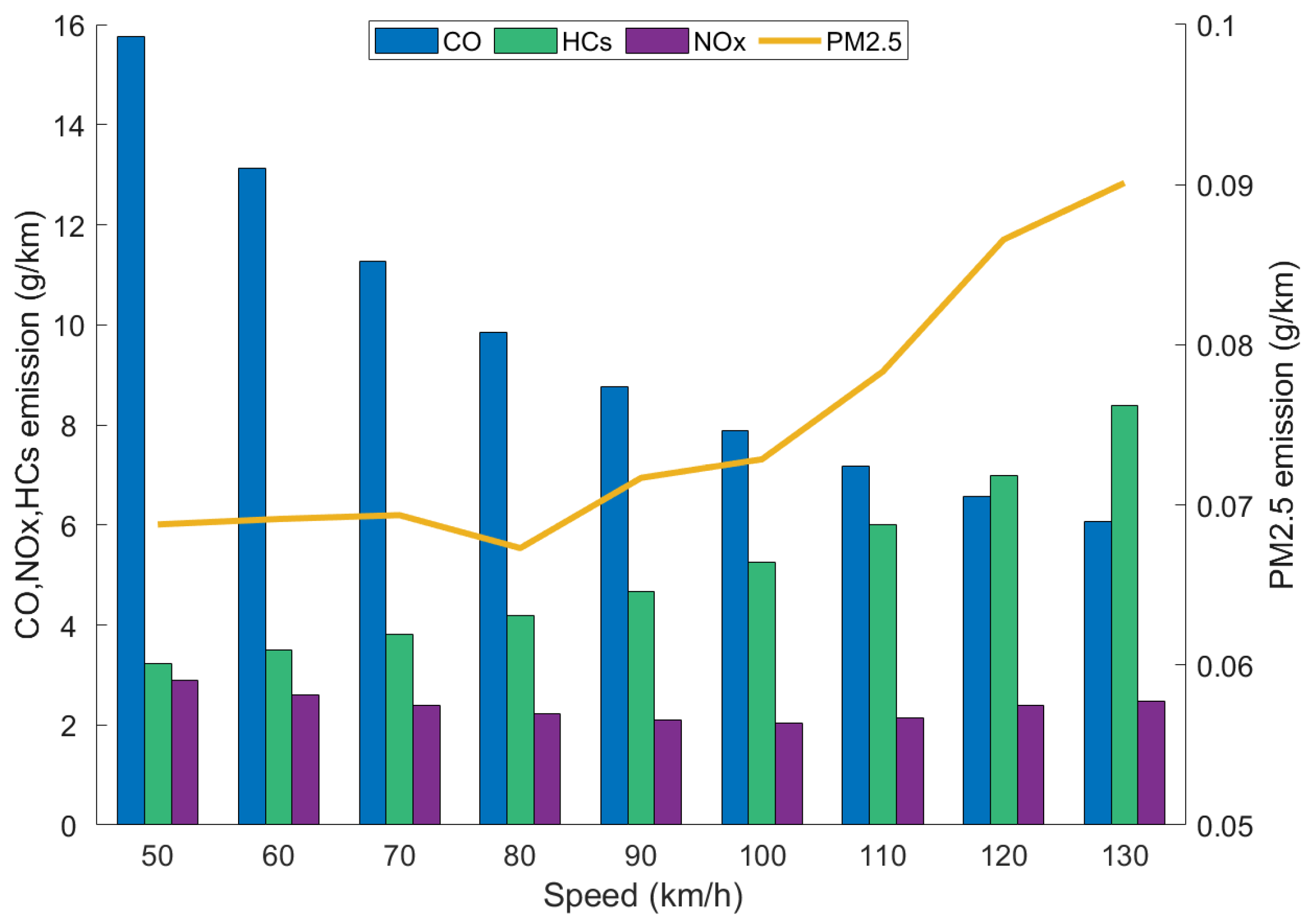
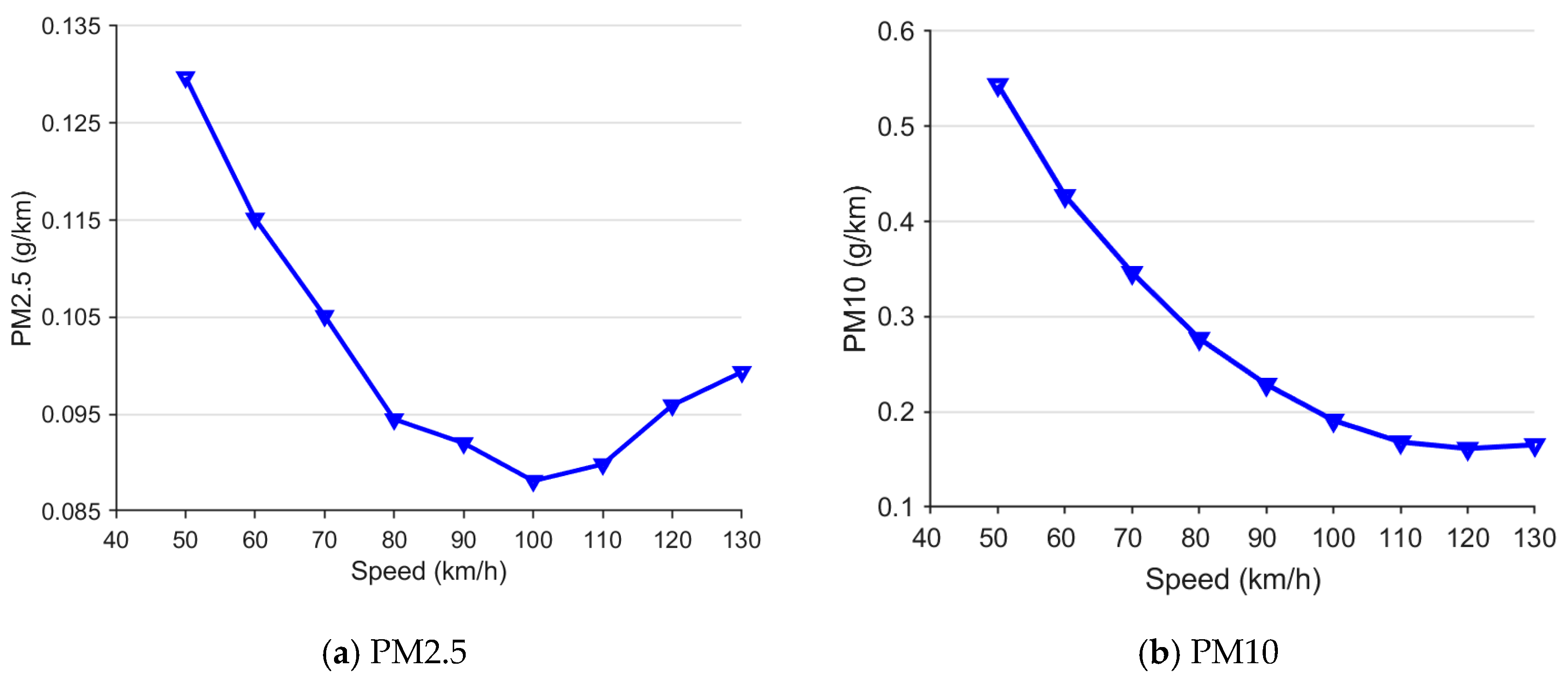
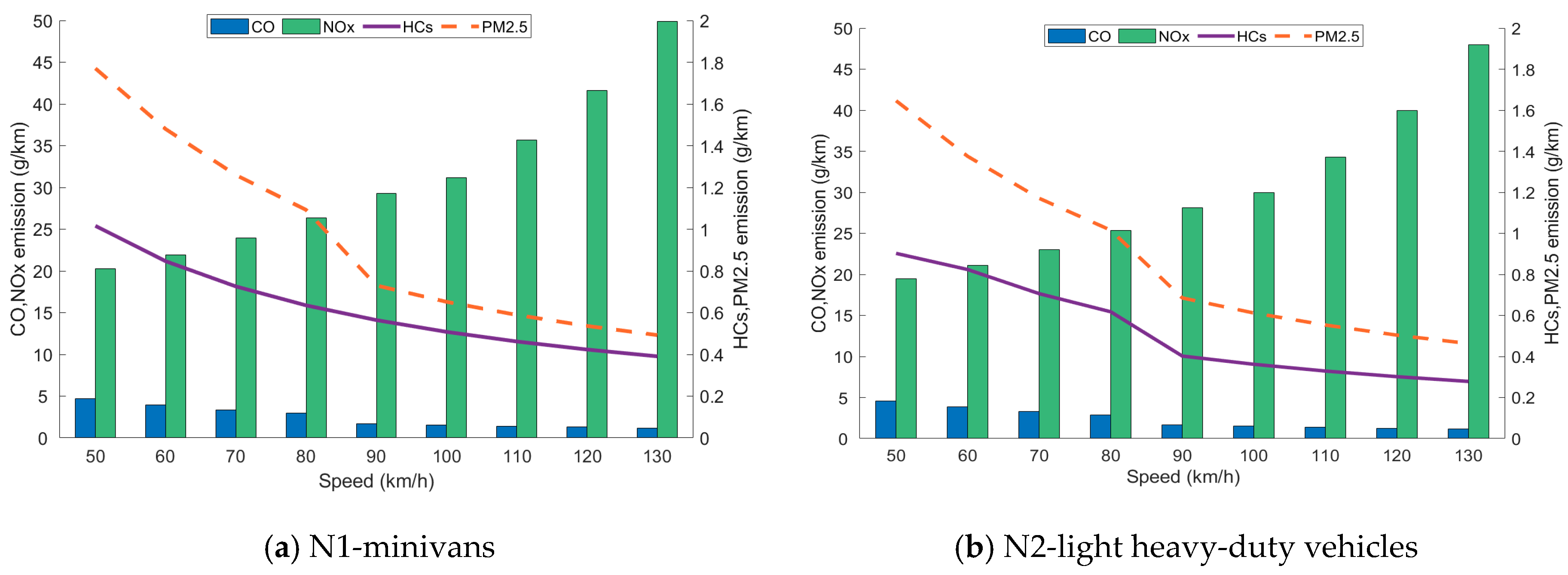
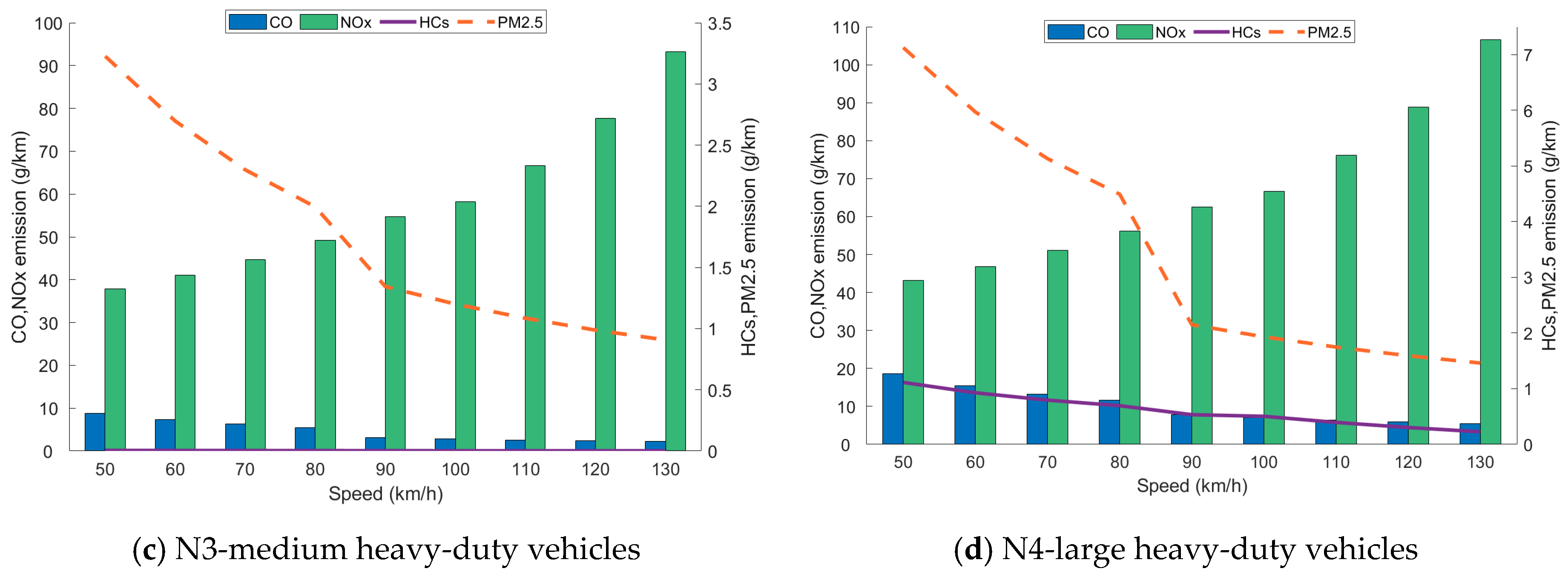
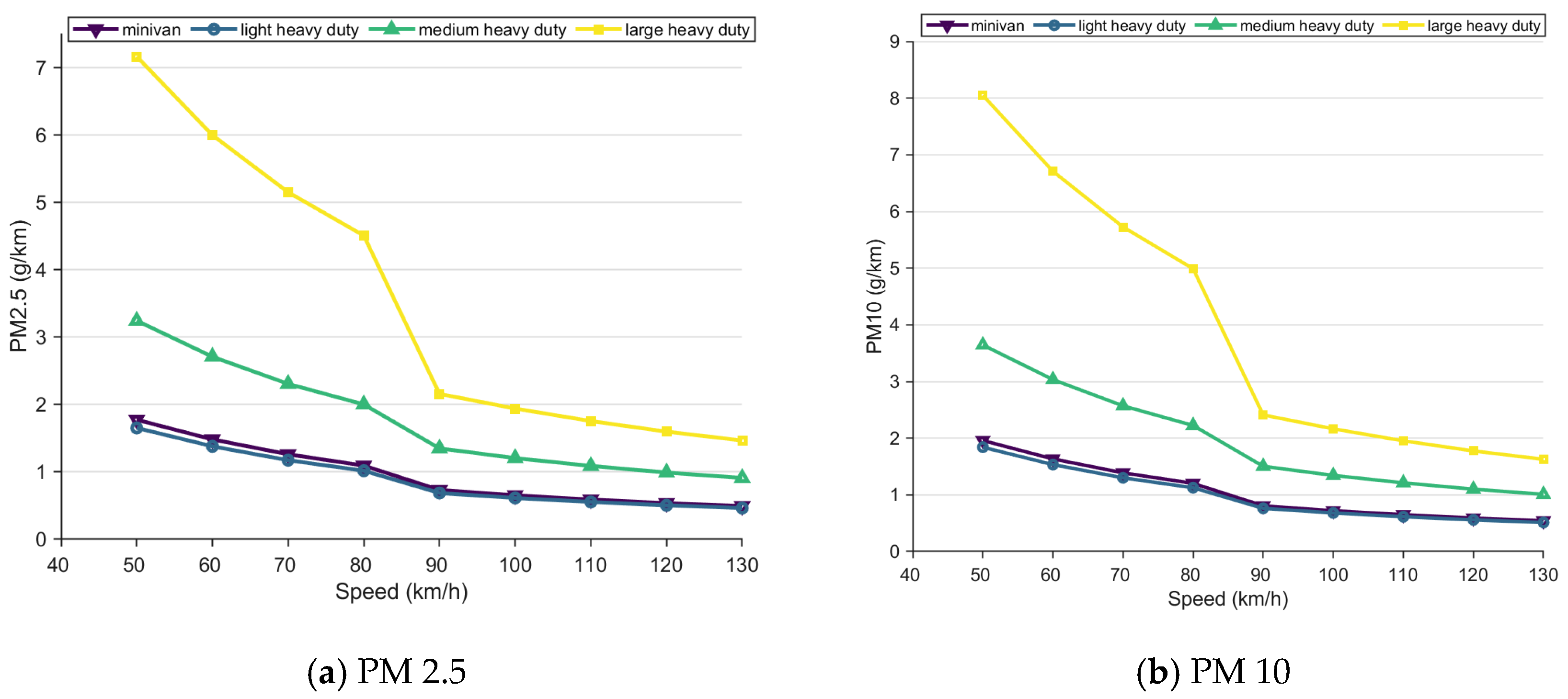

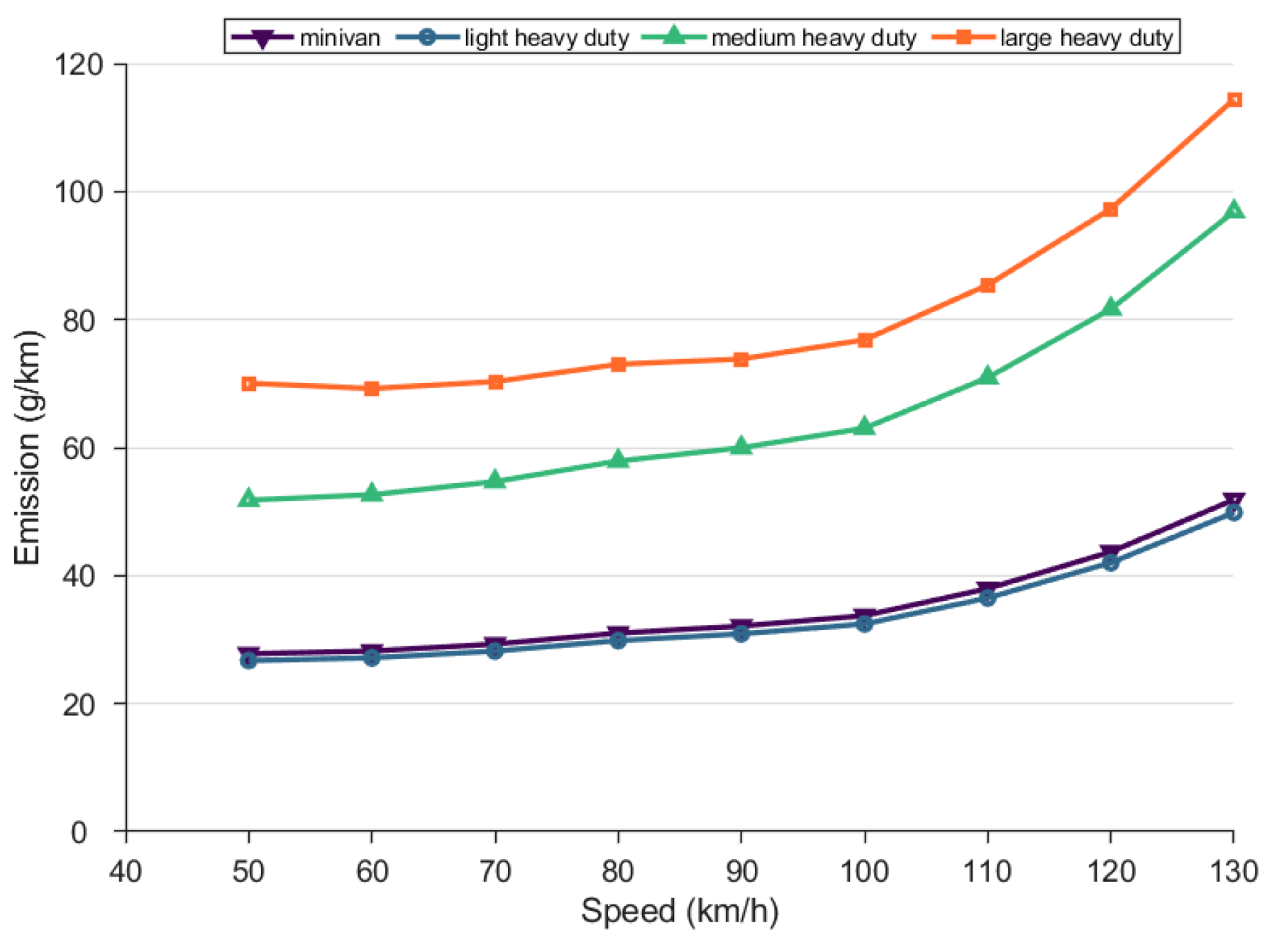


| Road Number | Light Vehicles | Medium Vehicles | Large Vehicles | Vehicle Trains |
|---|---|---|---|---|
| 1 | 75.33% | 9.67% | 6.67% | 8.33% |
| 2 | 88.56% | 7.96% | 0.90% | 2.59% |
| 3 | 84.98% | 6.58% | 7.64% | 0.81% |
| 4 | 86.00% | 7.60% | 3.22% | 2.78% |
| Research Road | Bi-Directional 4-Lane (km/h) | Bi-Directional 6-Lane (km/h) | Bi-Directional 8-Lane (km/h) | Bi-Directional 10-Lane (km/h) | |
|---|---|---|---|---|---|
| Vehicle Type | |||||
| Light vehicle | 60–100 | 60–90 | 90–115 | 80–100 | |
| Heavy vehicle | 60–95 | 30–70 | 70–105 | 65–90 | |
| Parameter | M1-Passenger Vehicle | N2-Freight Vehicle |
|---|---|---|
| Gross vehicle mass | 1757 kg | 12,000 kg |
| Representative vehicle | Volvo XC40 | Dongfeng DFL1160B |
| Outline dimensions | 4440 × 1863 × 1652 mm | 7800 × 2500 × 2900 mm |
| Emission standard | China 6 (GB18352.6-2016) [8] | China 5 (GB17691-2005) [56] |
| Engine displacement | 2000 ccm | 6500 ccm |
| Engine model | B4204T47 | EQH180-30 |
| Engine power | 140 kW | 132 kW |
| Engine manufacturer | Volvo Cars (Shanghai, China) | Dongfeng Cummins Engine Co., Ltd. (Wuhan, China) |
| Transmission type | electric | manual |
| Transmission manufacturer | Aisin Seiki | Dongfeng |
| Engine type | Gasoline | Diesel |
| Intake form | Turbocharged | Turbocharged |
| Emission reduction technology | Three-way catalyst (TWC) + GPF | SCR + DPF |
| Permitted limit emissions | CO: 1.0 g/km | CO: 1.5 g/km |
| HCs + NOx: 0.170 g/km | NOx: 2.0 g/km | |
| PM: 0.0045 g/km | HCs: 0.5 g/km | |
| NOx: 0.060 g/km | PM: 0.02 g/km |
| Parameter | Revised Option | Description |
|---|---|---|
| Simulation level | Project | |
| Year | 2009 | Comparing China-6 light-duty vehicle emissions standard with US standards, we established the model year as 2009. |
| Road type | Rural, restricted access | Corresponding to expressways in China. |
| Geographic location | Fulton, Georgia | We compared the latitude, precipitation, and temperature of the project site with those of various regions in the US and found them to be similar to the region of Fulton, Georgia, US. |
| Length of road section | 65 km | Actual project roadway length. |
| Traffic volume | 3500 vehicles/h | Actual project traffic volume obtained based on research |
| Emissions and fuel type | Light passenger vehicle—gasoline | Selection of model and fuel for different vehicles |
| Medium-sized passenger vehicle—gasoline | ||
| Large passenger vehicle—diesel | ||
| Minivan—gasoline | ||
| Freight vehicle—diesel | ||
| Freight vehicle train—diesel | ||
| Traffic composition | Light passenger vehicle—0.85 | Calibrated according to the actual project |
| Medium-sized passenger vehicle—0.01 | ||
| Large passenger vehicle—0.03 | ||
| Minivan—0.02 | ||
| Freight vehicle—0.06 | ||
| Freight vehicle train—0.03 |
| Speed Corresponding to the Minimum Exhaust Emissions (km/h) | Speed Corresponding to the Minimum Carbon Emissions (km/h) | ||
|---|---|---|---|
| Single-passenger vehicles | Traffic flow of passenger vehicles | Single-passenger vehicles | Traffic flow of passenger vehicles |
| 101.19 | 105.88 | 103.15 | 102.84 |
| Vehicle Type | Speed Corresponding to the Minimum Exhaust Emissions (km/h) |
|---|---|
| Single N-freight vehicles | 78.66 |
| N1-Minivan traffic flow | 61.89 |
| Traffic flow of N2-light heavy-duty vehicles | 62.04 |
| Traffic flow of N3-medium heavy-duty vehicles | 60.50 |
| Traffic flow of N4-large heavy-duty vehicles | 69.22 |
| Vehicle Type | Low-Emission Speed Range (km/h) | Low-Carbon Speed Range (km/h) |
|---|---|---|
| Small vehicles | 90–120 | 90–110 |
| Large vehicles | <100 | >80 |
Disclaimer/Publisher’s Note: The statements, opinions and data contained in all publications are solely those of the individual author(s) and contributor(s) and not of MDPI and/or the editor(s). MDPI and/or the editor(s) disclaim responsibility for any injury to people or property resulting from any ideas, methods, instructions or products referred to in the content. |
© 2024 by the authors. Licensee MDPI, Basel, Switzerland. This article is an open access article distributed under the terms and conditions of the Creative Commons Attribution (CC BY) license (https://creativecommons.org/licenses/by/4.0/).
Share and Cite
Liu, W.; Liu, J.; Yu, Q.; Shan, D.; Wang, C.; Wu, Z. Optimal Speed Ranges for Different Vehicle Types for Exhaust Emission Control. Sustainability 2024, 16, 10344. https://doi.org/10.3390/su162310344
Liu W, Liu J, Yu Q, Shan D, Wang C, Wu Z. Optimal Speed Ranges for Different Vehicle Types for Exhaust Emission Control. Sustainability. 2024; 16(23):10344. https://doi.org/10.3390/su162310344
Chicago/Turabian StyleLiu, Weiwei, Jianbei Liu, Qiang Yu, Donghui Shan, Chao Wang, and Zhiwei Wu. 2024. "Optimal Speed Ranges for Different Vehicle Types for Exhaust Emission Control" Sustainability 16, no. 23: 10344. https://doi.org/10.3390/su162310344
APA StyleLiu, W., Liu, J., Yu, Q., Shan, D., Wang, C., & Wu, Z. (2024). Optimal Speed Ranges for Different Vehicle Types for Exhaust Emission Control. Sustainability, 16(23), 10344. https://doi.org/10.3390/su162310344





